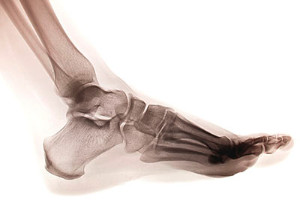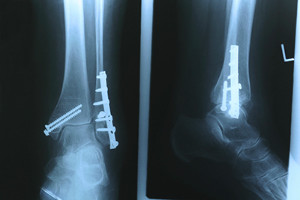Connect With Us
Blog
Items filtered by date: September 2022
What Is a Metatarsal Stress Fracture?

There are five metatarsal bones found in the foot, each connecting the heel/arch to the toes. These long bones play a critical role in helping the foot function. However, the metatarsal bones can suffer from what is known as a stress fracture, a crack in the bone that develops from repeated trauma. The metatarsal bones are the second most common bones in the lower limbs to suffer from stress fractures, the first being the tibia leg bone. Of the five metatarsals, the second and third metatarsal bones are the most commonly afflicted. One common symptom of a metatarsal stress fracture is pain felt in the foot when walking or running. If you are running long distances and are not wearing the right kind of footwear, you might be increasing your risk of developing a stress fracture. Contact a podiatrist today for more information about metatarsal stress fractures.
Activities where too much pressure is put on the feet can cause stress fractures. To learn more, contact one of our podiatrists from Comprehensive Foot & Ankle Centers. Our doctors can provide the care you need to keep your pain free and on your feet.
Dealing with Stress Fractures of the Foot and Ankle
Stress fractures occur in the foot and ankle when muscles in these areas weaken from too much or too little use. The feet and ankles then lose support when walking or running from the impact of the ground. Since there is no protection, the bones receive the full impact of each step. Stress on the feet can cause cracks to form in the bones, thus creating stress fractures.
What Are Stress Fractures?
Stress fractures occur frequently in individuals whose daily activities cause great impact on the feet and ankles. Stress factors are most common among:
- Runners
- People affected with Osteoporosis
- Tennis or basketball players
- Gymnasts
- High impact workouts
Symptoms
Pain from the fractures occur in the area of the fractures and can be constant or intermittent. It will often cause sharp or dull pain with swelling and tenderness. Engaging in any kind of activity which involves high impact will aggravate pain.
If you have any questions please feel free to contact our offices located in Shepherdsville and Louisville, KY . We offer the newest diagnostic and treatment technologies for all your foot and ankle needs.
It's Time for Beautiful Feet
Rheumatoid Arthritis and the Feet

Rheumatoid arthritis is a specific kind of autoimmune disorder that primarily impacts the joints and other body systems. Although individuals with rheumatoid arthritis (RA) can experience a wide range of different symptoms, foot pain is an important symptom of RA. For example, individuals with RA can experience swelling, pain, and abnormalities in the feet. Not only can this be annoying in and of itself for those with RA, it can also make falling or tripping due to weakened feet more likely. This can be especially problematic for older individuals who are already susceptible to trips and falls. If you are someone that suffers from rheumatoid arthritis and is experiencing foot pain, it is suggested you make an appointment with a podiatrist.
Because RA affects more than just your joints, including the joints in your feet and ankles, it is important to seek early diagnosis from your podiatrist if you feel like the pain in your feet might be caused by RA. For more information, contact one of our podiatrists of Comprehensive Foot & Ankle Centers. Our doctors will assist you with all of your podiatric concerns.
What Is Rheumatoid Arthritis?
Rheumatoid Arthritis (RA) is an autoimmune disorder in which the body’s own immune system attacks the membranes surrounding the joints. Inflammation of the lining and eventually the destruction of the joint’s cartilage and bone occur, causing severe pain and immobility.
Rheumatoid Arthritis of the Feet
Although RA usually attacks multiple bones and joints throughout the entire body, almost 90 percent of cases result in pain in the foot or ankle area.
Symptoms
- Swelling and pain in the feet
- Stiffness in the feet
- Pain on the ball or sole of feet
- Joint shift and deformation
Diagnosis
Quick diagnosis of RA in the feet is important so that the podiatrist can treat the area effectively. Your doctor will ask you about your medical history, occupation, and lifestyle to determine the origin of the condition. Rheumatoid Factor tests help to determine if someone is affected by the disease.
If you have any questions please feel free to contact our offices located in Shepherdsville and Louisville, KY . We offer the newest diagnostic and treatment technologies for all your foot and ankle needs.
Surgery for Ankle Fractures

An individual can break or fracture their ankle by experiencing different kinds of trauma, such as twisting ankle movements or injuries. If you have a fractured ankle, it is possible that the fracture is partial or complete in the affected bone. Additionally, the fracture may have developed where the ligament has been impacted. Sometimes, a medical professional will recommend undergoing a surgical procedure to treat a broken or fractured ankle if they believe that the injury will heal best with surgery. Particularly, if the fracture has spread to the joint in the ankle, a medical professional may recommend surgery. After undergoing a surgical procedure to treat a broken ankle, you may need to wear some sort of cast or splint for an extended period of time. This is largely dependent on the severity of your injury. You may also be instructed to limit the extent to which you put weight on the affected ankle. It is also possible that to continue to be mobile, you may have to use crutches following the surgery. If you have a broken ankle, contact a podiatrist who can assess your situation and discuss your options.
Broken ankles need immediate treatment. If you are seeking treatment, contact one of our podiatrists from Comprehensive Foot & Ankle Centers. Our doctors can provide the care you need to keep you pain-free and on your feet.
Broken Ankles
A broken ankle is experienced when a person fractures their tibia or fibula in the lower leg and ankle area. Both of these bones are attached at the bottom of the leg and combine to form what we know to be our ankle.
When a physician is referring to a break of the ankle, he or she is usually referring to a break in the area where the tibia and fibula are joined to create our ankle joint. Ankles are more prone to fractures because the ankle is an area that suffers a lot of pressure and stress. There are some obvious signs when a person experiences a fractured ankle, and the following symptoms may be present.
Symptoms of a Fractured Ankle
- Excessive pain when the area is touched or when any pressure is placed on the ankle
- Swelling around the area
- Bruising of the area
- Area appears to be deformed
If you suspect an ankle fracture, it is recommended to seek treatment as soon as possible. The sooner you have your podiatrist diagnose the fracture, the quicker you’ll be on the way towards recovery.
If you have any questions, please feel free to contact our offices located in Shepherdsville and Louisville, KY . We offer the newest diagnostic and treatment technologies for all your foot care needs.
Pinky Toe Ingrown Toenails

An ingrown toenail is a potentially painful and unsightly condition that usually affects the big toe. This condition occurs when the side of the toenail grows into the skin, creating redness and swelling in the affected area. However, it is also possible for an ingrown toenail to develop on the pinky toe. This can be problematic for several reasons. Most notably, the pinky toe is the smallest of all the toes, which makes taking proper care of the pinky toenail difficult. Many individuals can not properly trim or cut this toenail due to its small size, which is a leading cause of ingrown toenails. For example, toenails that are cut too short or in a misshapen way can develop into ingrown toenails. A good way to prevent this from happening to your pinky toes is to cut the toenail straight across. This can prevent the nail from growing into the skin. Another helpful method of prevention is to wear shoes that do not crowd the toes and offer sufficiently large toe boxes. The pinky is certainly a small and often neglected part of the human body. However, having an ingrown toenail on your pinky toe is nothing to take lightly. Reach out to your local podiatrist to learn more about treating your ingrown toenail.
Ingrown toenails can become painful if they are not treated properly. For more information about ingrown toenails, contact one of our podiatrists of Comprehensive Foot & Ankle Centers. Our doctors can provide the care you need to keep you pain-free and on your feet.
Ingrown Toenails
Ingrown toenails occur when a toenail grows sideways into the bed of the nail, causing pain, swelling, and possibly infection.
Causes
- Bacterial infections
- Improper nail cutting such as cutting it too short or not straight across
- Trauma to the toe, such as stubbing, which causes the nail to grow back irregularly
- Ill-fitting shoes that bunch the toes too close together
- Genetic predisposition
Prevention
Because ingrown toenails are not something found outside of shoe-wearing cultures, going barefoot as often as possible will decrease the likeliness of developing ingrown toenails. Wearing proper fitting shoes and using proper cutting techniques will also help decrease your risk of developing ingrown toenails.
Treatment
Ingrown toenails are a very treatable foot condition. In minor cases, soaking the affected area in salt or antibacterial soaps will not only help with the ingrown nail itself, but also help prevent any infections from occurring. In more severe cases, surgery is an option. In either case, speaking to your podiatrist about this condition will help you get a better understanding of specific treatment options that are right for you.
If you have any questions please feel free to contact our offices located in Shepherdsville and Louisville, KY . We offer the newest diagnostic and treatment technologies for all your foot and ankle needs.
Blog Archives
- July 2025
- June 2025
- May 2025
- April 2025
- March 2025
- February 2025
- January 2025
- December 2024
- November 2024
- October 2024
- September 2024
- August 2024
- July 2024
- June 2024
- May 2024
- April 2024
- March 2024
- February 2024
- January 2024
- December 2023
- November 2023
- October 2023
- September 2023
- August 2023
- July 2023
- June 2023
- May 2023
- April 2023
- March 2023
- February 2023
- January 2023
- December 2022
- November 2022
- October 2022
- September 2022
- August 2022
- July 2022
- June 2022
- May 2022
- April 2022
- March 2022
- February 2022
- January 2022
- December 2021
- November 2021
- October 2021
- September 2021
- August 2021
- July 2021
- June 2021
- May 2021
- April 2021
- February 2021
- January 2021
- December 2020

